From voice communication to data communication, cellular mobile phones are undoubtedly in a major revolutionary period of technological architecture change. In the digital age, wireless communication, like wired communication, continues to increase the transmission rate: from GSM to transmission rate. 40Kbps GPRS, and transmission rate of about 130Kbps EDGE, and then to 384Kbps of 3G generation UMTS, to the current generation of 3.5 generation HSDPA.
This article refers to the address: http://
A new term currently in the mobile phone market is the HSDPA, which is known as 3.5G. It will become a topic of concern in the market, and it has its significance in the times. First, CDMA2000 has gained a leading edge in the 3G market, which has put tremendous pressure on the WCDMA camp. In addition, it is the WiMAX momentum promoted by the wireless network camp. The vastness of the WCDMA camp is urgently needed to introduce a new generation of technology to consolidate the existing mountains and rivers.
Let's take a look at the current status of the current 3G market. According to GSA and CDG statistics, the number of commercial networks for WCDMA, CDMA2000 1X and CDMA2000 1xEV-DO in 2004 was only 37, 87 and 10 respectively, and as of June 2005, 223 3G commercials have been launched worldwide. The network has 123 CDMA2000 1X networks and 22 CDMA2000 1x EV-DO networks. In comparison, there are only 78 WCDMA networks. It is expected that 22 CDMA2000 1X EV-DO network plans will be opened next year. There are seven telecom companies in the WCDMA network ready to enter the commercial phase, please refer to (Figure 1).

Figure 1 Global 3G commercial network growth trend
If the number of users is compared, the difference between the two camps is even more obvious. According to the information released by the Institute of Telecommunications of the Ministry of Information Industry of China, as of the end of June 2005, there were 191.9 billion 3G users worldwide, of which CDMA2000 1X users reached 1.437. Billion, EV-DO users also have 17.8 million, but WCDMA users only have 30.4 million.
For countries with two parallel specifications at the same time, this situation makes the telecom operators using WCDMA feel worried, and the number of users who are worried about rising will be lost to another camp. The representative countries are Japan, the United States and China. Among them, NTT DoCoMo has planned to invest 350 million US dollars in two years from 2004 to fund six terminal manufacturers (Fujitsu, Mitsubishi Electric, Motorola, NEC, Panasonic, Sharp). Accelerating the development of HSPDA mobile terminals to combat KDDI's wireless high-speed data services, KDDI announced that it will open CDMA2000 1x EV-DO Rev.A network at the end of 2006 to increase the uplink/downlink rate to 1.8/3.1Mbps.
In the US, Verizon Wireless' EV-DO system has covered 32 cities, with a population coverage of over 30%, and is projected to exceed 40% by the end of 2005. In response to the competition, Cigular, the largest mobile communication service provider in the United States, announced the upgrade of the WCDMA system at the end of 2004. It plans to deploy HSDPA networks in urban and campus areas in several major US cities by the end of 2005. In China, China Unicom has begun to vigorously promote the cdma2000 1x EV-DO system, which will undoubtedly create competitive pressure on China Mobile. To this end, China Mobile said that after the issuance of 3G licenses, China Mobile will first deploy HSDPA networks in developed and important cities along the coast.
Comparison of two major 3.5G standards
Reviewing the development of two competition specifications, the International Organization for Standardization 3GPP/3GPP2 launched these two technologies in 2000. In terms of 1xEV-DO, 3GPP2 has completed the standardization of Rev0 and RevA (reverse enhancement), and is developing the RevB standard. It is expected that the RevB version will be standardized in early 2006.
3GPP has divided the evolution of HSDPA into three phases. The first phase is started in 2000. The basic HSDPA is defined in the R5 version. At this stage, the phase has been completed. After introducing HS-DSCH channel, AMC and HARQ technologies, the ideal peak value is obtained. The rate is up to 14.4Mbps; the second stage is the enhanced HSDPA defined by the R6 version, which increases the peak rate to 30Mbps by adopting MIMO technology; the third stage will jointly adopt OFDM and 64QAM modulation technology to achieve a peak rate of 50Mbps or more. Please refer to (Table 1), (Figure 2), (Figure 3).

Table 1 HSDPA development stage and key technologies
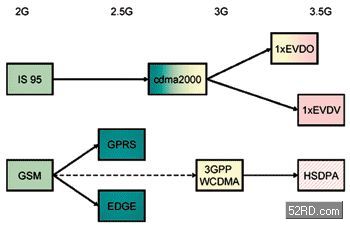
Figure 2. Evolution of HSDPA and CDMA 1xEV-DO standards
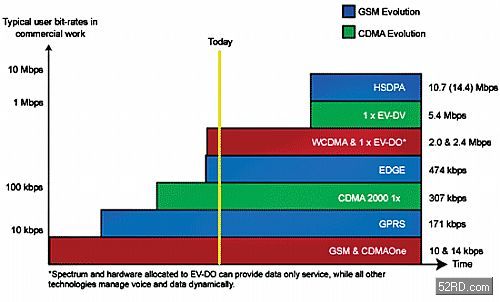
Figure 3: Evolution of the performance of honeycomb technology
In order to protect the investment of the industry, both standards are based on the principle of making minimal changes to the existing network, that is, to try not to change the network architecture and core network, and to use the existing spectrum resources. In this case, it is necessary to carry out innovation through advanced technology, and both standards use technical methods such as AMC and HARQ. The following will be a comparative explanation.
â– 1xEV-DO
1xEV-DO (Evolution-Data Optimized) is a commercially viable 3G technology that can increase the data transmission rate to 2Mbps, using a bandwidth of 1.25MHz, compared to CDMA2000 1xRTT and WCDMA. The center's technology is 3 to 4 times faster.
Although 1xEV-DO is part of the CDMA2000 standard, it does not rely on any component in the CDMA voice network to provide service, mobility or roaming. System operators do not need a Mobile Switching Center (MSC) or network components such as home and visitor location registers (HLR/VLR). Therefore, regardless of the voice technology currently used by the system operators, 1xEV-DO can be built as long as it has a paired spectrum of 1.25 MHz.
There are three main units in the 1xEV-DO network, as shown in Figure 4:
â—Radio Nodes (RNs)
â—Radio Network Controller (RNC)
â— Packet Data Serving Node (PDSN)
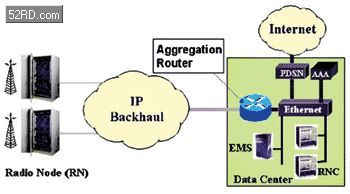
Figure 4 1xEV-DO network architecture
Each wireless node typically supports three sectors and serves a cellular system, and each region has a dedicated transmitter that is used to throttle the air link between the user data plane and the wireless node. Higher layer protocols in 1xEV-DO are handled in the RNC, which is also responsible for passing user data between the RN and the PDSN. The PDSN is an EDGE Router used to connect wireless networks to the Internet. What makes this architecture different from some other 3G wireless technologies is that it does not need to rely on the Mobile Switching Center (MSC).
In addition to the RNC and PDSN, the 1xEV-DO data center has an aggregation router, an element management system (EMS) and several ISP servers. The aggregation router fetches the IP information from the RN and transmits it to the RNC; the EMS manages the wireless access network. As for the commonly used ISP servers, such as the Domain Name System (DNS), the Dynamic Host Configuration Protocol (DHCP), and the Authentication, Authorization, and Accounting (AAA) standards. IP server.
Overall, 1xEV technology (also known as High Data Rate; HDR) is a high-performance and cost-effective Internet solution that is compatible with and optimized for CDMA networks. Packet data service. More specifically, it achieves its performance with minimal network and spectrum resources and is a high spectral efficiency technology.
â– HSDPA
HSDPA (High-Speed ​​Downlink Packet Access) is an additional solution based on the 3GPP R99/R4 architecture, which is an empty intermediation plane of UMTS. The architecture mainly includes three components, namely User Equipment (UE) and Node. B and Radio Network Controller (RNC), as shown in Figure 5. Under the basic standard, Category 6 mobile users using rake receivers have a peak data transmission rate of 3.6 Mbps; Category 10 mobile users with advanced receiver solutions Then it can be upgraded to 14.4Mbps.
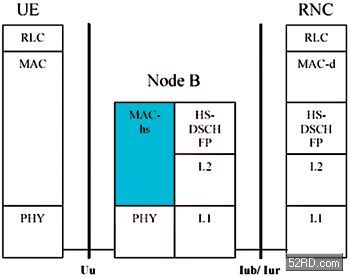
Figure 5 HSDPA agreement architecture
HSDPA is based on the evolution of existing WCDMA networks, and its network construction cost is mainly used for software/hardware upgrades of Node B (base station) and RNC. It transfers key data processing from the RNC to the Node B, bringing data processing closer to the empty intermediaries, enabling higher system throughput and improved service quality. Not only that, but HSDPA also expands system capacity. Compared to existing WCDMA technologies, HSDPA can serve more high-speed users on the same wireless carrier frequency.
Basically, HSDPA is a packetized data service for WCDMA downlink, and its data transmission rate can reach 8 to 10 Mbps at a bandwidth of 5 MHz (up to 20 Mbps using a MIMO system). It adds a new High Speed ​​Downlink Shared Channel (HS-DSCH), which uses split code to split the main channel into 15 sub-channels with a shortened TTI (transmission time interval). Channel time allocation for different users in 2ms. In this way, multiple users can share the bandwidth at the same time, which improves the spectrum utilization.
In addition, it also introduces shorter TTI (2ms) in the physical layer (PHY), technology using adaptive modulation and coding, and fast retransmission of HARQ to enable high-speed transmission. Its technical features are as follows:
Adaptive Modulation and Coding (AMC)
In order to provide the best data rate for each user, an adaptive modulation and channel coding scheme is employed in HSDPA to meet current channel conditions.
Fast scheduling
In WCDMA, packet scheduling is handled by the RNC. In HSDPA, packet scheduling is transferred to the Node B itself, so the delay due to conditional changes can be greatly reduced. In order to get the maximum efficiency of scheduling data packet transmission, HSDPA uses channel quality information, mobile terminal capabilities, QoS, and available power/code.
Fast retransmission
Data retransmission is required when a link error occurs. The current WCDMA system must wait for a time of 100 ms or longer before the RNC re-responds. Introducing this functionality into Node B will reduce the delay by an order of magnitude of around 10ms. This approach uses hybrid ARQ (HARQ) technology, in which previously transmitted data and retransmitted data are combined in a special way to improve decoding efficiency and dispersion gain.
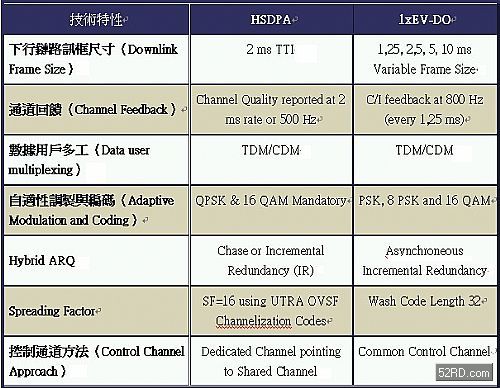
Table 2 Comparison of technical characteristics of 1xEV/DO and HSDPA
Comprehensive comparison
As mentioned earlier, both standards are similar or identical regardless of technical purpose or means. Both demand to meet the needs of asymmetric data services, that is, to provide high-speed downlink transmission speed, so that operators can promote mobile value-added services such as video entertainment. However, in order to reduce the cost and impact of network upgrades, in addition to considering the compatibility with the existing version, it is required to achieve the spectrum utilization improvement with the minimum hardware and software adjustment.
At present, it seems that the commercialization of 1xEV-DO is relatively fast, which has a great relationship with the compatibility of a series of CDMA standards. Unlike the upgrade from GSM/GPRS to WCDMA, it needs to significantly change the network infrastructure. However, slow development also means more experience for reference, so the technical version of HSDPA has a higher data transfer rate, and can fully use the remaining speech and audio width. In addition, HSDPA can support both voice and data. service.
However, the evolution of these two standards is just beginning, and it is foreseeable that the future direction of development will not be much different. At the physical layer, spectrum utilization will continue to be improved; QoS is an essential technology in high-level agreements because multiple services or applications can be performed simultaneously; as for the technology of transmitting and receiving and modulating, each wireless Technologies are developing without exception, using strategies such as MIMO, OFDM, and smart antennas.
HSDPA mobile phone development technology challenges
Although HSDPA emphasizes that the network architecture does not require major changes, it can provide higher-speed services, that is, as long as the existing WCDMA/3G mobile phone can enjoy higher download speed, but to achieve the best Receiver rates, manufacturers of mobile terminals still face significant development challenges.
At this stage, the transmitting end of the HSDPA mobile phone basically does not need to be changed. The first impact is the improvement of the receiving technology. All cellular communication systems face two basic problems: multiple access interference and multipath interference. In recent years, the air intermediaries technology revolutions, such as FDMA, TDMA, and CDMA, can be attributed to the advancement of multiple access technologies. As for the overcoming of multipath interference, smart antennas, rake receivers, and OFDM technologies have emerged. At present, most of the advanced receiving schemes introduced for HSDPA use rake receivers, although they have improved effects, The first generation of 14.4 Mbps peak download rate is still not reached.
Therefore, the next step is to start with the antenna and receiver design architecture. One of the methods is to use Diversity Reception, which is to add a second antenna and receiver, receive signals through two independent signal receiving paths, and pass complex modulation and coding techniques. Combine the two for better signal results. However, the design of this method is difficult, and the extra circuit may increase the size of the device. In order to obtain the best difference benefit, the farther the two antennas need to be separated, the better the design engineering challenges.
Another similar strategy is to adopt popular MIMO technology, which is also the application technology of 3GPP in the second phase of HSDPA. MIMO subverts the basic theory of multipath interference, instead proposes the theory of spatial multiplexing, emphasizing the improvement of transmission efficiency through multipath reflection. At present, MIMO technology has been introduced in the new WLAN product (Pre N) and can break the transmission rate of 100 Mbps, and the honeycomb system will be visible in the future.
As the receiving efficiency increases, the mobile phone system also faces an overall design problem. When the amount of data transmission is greatly increased, the processing efficiency of the mobile phone is also improved, which can be divided into the basic frequency processing capability of the communication segment and the multimedia processing capability of the application segment. At present, these two segments are developing in the direction of technology independence to meet their different needs in terms of technical extension and market demand. The chip industry also emphasizes an open architecture to provide manufacturers with flexible choices of diversification. Obviously, in order to achieve the expected performance of the HSDPA mobile phone, the design challenges of its hardware and software will be greatly enhanced. In addition to the need to use a stronger processor or accelerator to enhance the processing power, the large amount of data received also needs to be larger. The memory capacity is stored.
Not only that, but the components in the system also need to be connected in series with a higher speed and intelligent bus, and adopt various energy-saving strategies to extend the life of the battery. These strategies include avoiding high-clock processors, using lower voltages, improving computational efficiency, and optimizing power management strategies for the overall system, such as intelligently letting inactive components or modules go to sleep. And other power saving modes.
Solution market status
At present, the commercialization of HSDPA mobile phones is still in its infancy, and related hardware solutions are still quite limited. Leading-edge vendors are undoubtedly the leader in CDMA, Qualcomm, which has launched two generations of HSDPA solutions, including the first-generation MSM6275 chipset and the second-generation MSM6280 chipset, which will be held at the Beijing International Communications Exhibition at the end of October this year ( PX/EXPO Wireless) Two HSDPA data cards introduced by Sierra Wireless and Huawei, using Qualcomm's MSM6275, have a downlink rate of 1.8Mbps. Qualcomm launched the MSM6280 in October this year, in addition to the 90-nm process, and integrated advanced receiving technology such as receive diversity and equalizer, in one fell swoop to increase the downlink rate to 7.2Mbps.
Freescale launched the i.300-30 3G platform in early 2005, which is a multi-mode solution that supports GSM, EDGE GPRS, WCDMA and HSDPA. The downlink transmission rate of HSDPA can reach 3.6Mbps. TI has TMS320TCI6482 programmable DSP to support HSDPA, but this is the baseband solution for wireless base stations; mobile phone part, its OMAP-Vox series of advanced products OMAPV1030 chipset currently supports GSM/GPRS/EGDE, but promised Will help customers in this series to make a smooth transition to UMTS and HSDPA.
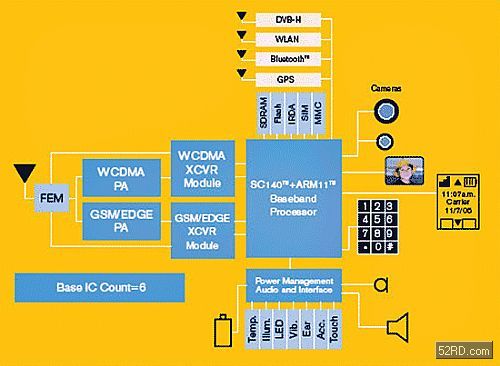
Figure 6. Freescale's i.300-30 multimode platform architecture
In the software agreement, TTPCom also worked with Icera to develop the HSDPA/EDGE solution. The solution uses TTPCom Release 5 multi-mode wireless protocol stack to support existing GSM, GPRS and EDGE, WCDMA and HSDPA wireless terminal equipment standards with a data transmission rate of 3.6Mbps. In addition, TTPCom has also entered into a cooperation agreement with ARM to jointly design and develop a 3G platform integrating the ARM processor and TTPCom's mobile baseband engine (CBEmacro).
In terms of test instruments, HSDPA has also brought great business opportunities to this market, including Agilent, Tektronix and Rodd Schwarz, which have already been deployed, and launched a series of designs for mobile phone manufacturers and telecom operators. Various instruments to interoperability testing. Agilent and Anite jointly launched a single platform integrating GSM, GPRS, EGPRS, W-CDMA and HSDPA testing capabilities - the SAT test platform, which is designed for initial development from Layer 1 to Layer 3. Development tools, based on the Agilent 8960 wireless communication test system, range from initial RF and protocol testing to complete conformance and inter-operability verification. Tektronix's main product in HSDPA is the NetTek tester, an RF field test tool that allows RF technicians and performance test engineers to accurately analyze the performance of NodeB transmitters and expertly diagnose problems; in addition, the NetTek tester simultaneously Demodulation tests are also provided, including EVMs that are critical to understanding the RF signal environment. Rohde Schwarz also offers a range of HSDPA tools, including RF communication testers (CMU 200/300), protocol testers, signal analyzers and more.
in conclusion
From voice communication to data communication, cellular mobile phones are undoubtedly in a major revolutionary period of technological architecture change. In the digital age, wireless communication, like wired communication, continues to increase the transmission rate: from GSM to transmission rate. 40Kbps GPRS, and the transmission rate of about 130Kbps EDGE, and then to the 3G generation UMTS 384Kbps, and now the 3.5 generation HSDPA, the first stage is to see 14.4Mbps. In the launch schedule, LG, NEC and Samsung have all said that they will launch HSDPA commercial phones by the end of this year or early 2006.
Although technically feasible, there is no guarantee that the market will be able to make a quick transition. At present, 3G mobile phones are facing different compatibility problems with 2G/2.5G technology architecture. How to switch calls smoothly between the two generations of network systems that coexist, and maintain the quality of calls and provide emerging services is designed today. A big challenge. Another problem that will be faced is the experience of actual service. After all, the current transmission rate is the ideal value on the table. In real applications, it will encounter bottlenecks such as sharing, interference and delay, and the quality of service can be obtained by users. The identity will be worth watching.
From another point of view, although the WCDMA camp is relatively backward in the promotion of 3G, as far as the fundamentals are concerned, as of the end of August 2005, there are 670 GSM networks in 200 countries or regions, and the number of users reached 15.2. In comparison, CDMA is only used by nearly 300 million users in 80 countries, so WCDMA still has an excellent development foundation, and it does not have to be arrogant. However, in the cellular system, there has been a problem of patent monopoly for a long time. The promotion of technology has always been the biggest fatal injury, and it has also made it possible for the network camps such as Wi-Fi/WiMAX to have a chance to come later. This is what the 3G industry needs. A place of deliberation.
Acrylic Watch Holder,Hanging Watch Holder,Acrylic Watch Display Rack
Yuefeng Display Product Co., Ltd. , http://www.mw-acrylicdisplay.com